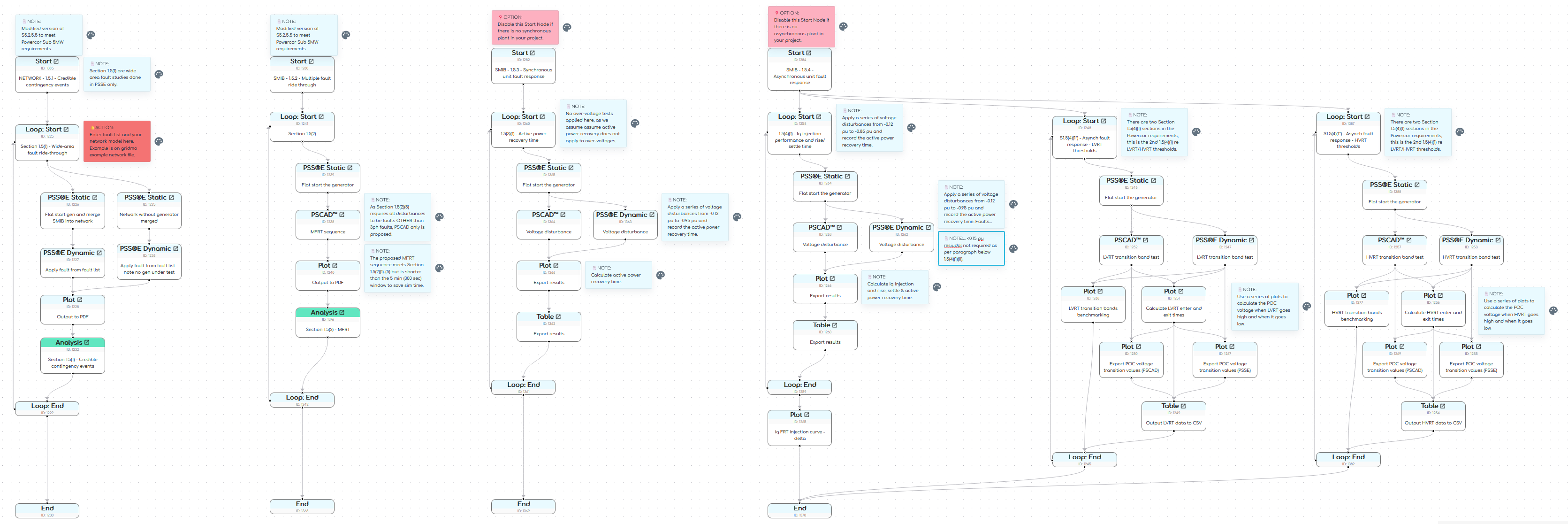Template: Powercor Sub 5MW Generator Performance Standard Guideline

Template version: v4
Country:

AU
Software required:
Source: v1.0 (18 Feb 2021)

Background
This gridmo template:
- Includes tests required as per the Powercor | Sub 5 MW GPS Guideline | Feb 2021 which are typically completed in PSS®E and PSCAD™.
Reference
Common assumptions
- This template does not include the following sections of the guidelines (as they are not typically completed using dynamic power systems simulation software):
- 1.1: Steady State Reactive Power Capability - we provide a template section to create a dynamic PQ constrained capability graph. However we do not currently provide the unconstrained PQ capability graph, which is typically completed in DIgSILENT PowerFactory.
- 1.2: Quality of electricity generated - typically completed in DIgSILENT PowerFactory.
- 1.6: Quality of Supply Tolerance - typically completed by providing evidence of immunity from OEM.
- 1.8: Protection of generating systems - not normally completed in power system simulation software.
- 1.9: Coordination of Protection System - not normally completed in power system simulation software.
- 1.10: Unstable Behaviour - not normally completed in power system simulation software.
- 1.12: Impact on network capability - normally demonstrated using the Section 1.5(1) results.
- 1.15: Remote Monitoring and control - not normally completed in power system simulation software.
- 1.16: Fault current.
Section 1.1: Steady State Reactive Power Capability:
- The template is pre-configured to test between
-0.90(absorbing) and0.90(injecting) power factor as per theLoadcolumn of this section of the Powercor requirements (to support BESS projects). If you have no load component in your generating system, you can remove the excess rows (rows with power factor step outside of the range-0.93to0.93from theLoop StartNodes1097,1120and1112). - Please replace the reference to
GEN=999#1inside thePSS®E StaticNodes1099,1122and1114with the definition of your PSS®E slack bus generator as per your SMIB model. - If your generating system does not support power factor control, please contact gridmo support to discuss the template changes required.
- If you rely on on-load tap changers to get the required PQ capability, we recommend overriding the normal tap transition time of the tap changer(s) with a much smaller time, so they can settle quickly during these tests.
Section 1.3: Response to frequency disturbances
- If you require PSCAD™ dynamic results instead of only PSS®E, please enable the
PSCADNodes1142and1152. Note these are very long PSCAD™ simulations which may take a long time to simulate.
- It is unclear if both PSS®E and PSCAD™ results are required for this test. The template is configured to run both PSS®E and PSCAD™ studies, however the PSCAD™ simulation is disabled by default.
Section 1.4: Response to voltage disturbances
- It is unclear if both PSS®E and PSCAD™ results are required for this test, both have been included for completeness.
We have assumed that the voltage ranges specified in Section 1.4 Table 10 are for primary asset withstand only - and therefore do not form part of the voltage withstand capability of the generating system. For example:
- Remaining connected for a 10 second long -100% voltage single phase or phase-phase fault would require islanding of the Powercor distribution network, which we assume is not desirable.
- Similarly, the +50% to +80% single phase voltage ride-through requirements are well in excess of the NER S5.2.5.4 requirements (and in most cases, well beyond the capability of many generating systems) and are assumed to be primarily for primary asset rating on distribution networks with rapid earth fault current limiters (REFCLs) fitted.
Therefore - we have not included any PSS®E or PSCAD™ tests for Section 1.4 Table 10 in this template.
Section 1.5(1): Credible contingency events
- Convert the distribution and/or transmission fault list provided by Powercor (or otherwise proposed/agreed) into gridmo fault commands in the
Loop StartNode1225. The example faults within theLoop StartNode in the template are examples only. - Add the correct relative fault paths for your PSS®E network model into the
Loop StartNode1225. If you have multiple network models or network model cases, modify theLoop StartNode1225to repeat the faults for each network case as applicable.
Section 1.5(2): Multiple fault ride through
The template comes pre-configured with a single multiple fault ride through (MFRT) test, with the following faults being applied. Note the below MFRT sequence meets the requirements of this section of the guidelines regarding fault spacing, residual voltage and fault types - but is shorter than the 5 minute (300 second) duration specified to minimise PSCAD™ dynamic simulation time.
| # | Type | Duration | Fault impedance | Next fault after [sec] |
|---|---|---|---|---|
| 1 | 1PHG | 220 ms | 0 (bolted) | 0.2 sec |
| 2 | PH-PH | 430 ms | 0 (bolted) | 5 sec |
| 3 | 1PHG | 500 ms | 70% residual | 30 sec |
| 4 | 2PHG | 220 ms | 60% residual | 30 sec |
| 5 | 1PHG | 430 ms | 60% residual | 30 sec |
| 6 | 1PHG | 220 ms | 0 (bolted) | N/A |
If your generating system requires a longer MFRT sequence in order to provide a more stable response, then please increase the spacing of the SIMPLEFAULT commands in the PSCAD™ Node 1238 as required - or alternatively enter a different sequence of faults.
- We have assumed that the MFRT test should be completed in PSCAD™ only, as all faults in the sequence are unbalanced faults.
Section 1.5(3): Synchronous unit fault response
- If you have no synchronous plant in your generating system, this section is not applicable and thus can be disabled (disable
Start Node1282).
Section 1.5(4): Asynchronous unit fault response
- If you have no asynchronous plant in your generating system, this section is not applicable and can be disabled (disable
Start Node1284).
Section 1.7: Partial load rejection
If your generating system is comprised of only grid-following asynchronous plant, then you could instead propose compliance with Section 1.7 via demonstrating compliance with Section 1.3 of the guidelines. Specifically, you could assert that any system separation event, regardless of load reduction of pre-disturbance level cannot exceed the minimum frequency band and ROCOF as per Section 1.3 of the guidelines.
However - if you have a synchronous plant or grid-forming inverters in your generating system, the inertia of your generating system may need to be considered in your generating system's ability to maintain continuous uninterrupted operation during a partial load rejection event.
If you propose to demonstrate compliance with Section 1.7 via a system separation event:
- Configure the
Loop StartNode1288with the correct relative file paths for your PSS®E network model - Inside
PSS®E DynamicNode1290, add the fault orSET, STATUS=OUT, AT=commands you intend to use to simulate the network separation event.
If you intend to demonstrate compliance with Section 1.7 via the tests in Section 1.3, then this section is not applicable and can be disabled (disable Start Node 1288).
Section 1.13: Voltage and reactive power control
The Powercor GPS guidelines specifies that a generating system must:
...have facilities with a control system to regulate voltage, reactive power or power factor.
The template has been configured for all three control modes (fixed Q, fixed PF and voltage control / voltage droop) to be tested - but not all may be applicable to your generating system. For voltage control / voltage droop control, an optional Q(V) droop curve is also generated.
- If your generating system does not support fixed Q control, disable
StartNode1234. - If your generating system does not support fixed PF control, disable
StartNode1236. - If your generating system does not support voltage control / vdroop, disable
StartNode1232.
- We have assumed compliance with these technical requirements can be completed using SMIB models only - if PSS®E network studies are required, the relevant sections of S5.2.5.13 can be copied from the AEMO GPS template. template into this flow.
Sources
- AEMC | National Electricity Rules | Version 200 | 30 May 2023
- AEMO | Power System Model Guidelines | Version 2 | July 2023
- AEMO | Guide to generator exemptions and classification of generating units | Version 5.4 | August 2022
- Powercor | Sub 5 MW GPS Guideline | Feb 2021
Revision history
Version 4 | 12 December 2025
Improvements- Added Action Nodes.
- 1.5.1 - Credible contingency events: Updated Run to use sample gridmo network model (
distnetworkexample.sav) with examples of how to define faults. - 1.7 - Partial load rejection: Updated Run to use sample gridmo network model (
distnetworkexample.sav) with examples of how to define load reduction event.
- 1.1 - Frequency control: Added OUTPUT command in Plot Node
1299to output change in active power in p.u.i_ppoc_pu_difffor Table Node1306. - 1.4 - Response to voltage disturbances: Removed
TAT=1025argument forADVBANDScommands in Plot Node1191, as the simulation length is 50 seconds. - 1.5.4 - Asynchronous unit fault response: Removed
HVRT enter timeandHVRT exit timeinternode variables from Table Node1254. Also changed column name for{{i_poc_v_when_into_lvrt}}toPOC voltage when enter LVRTin Table Node1249.
Version 3 (v1.4.20) | 21 January 2025
- Updated descriptions in template for Nodes, Plot subtitles and file names to better describe tests.
- S5.2.5.5 FRT transition bands: Split the Plot Nodes which were calculating the LVRT and HVRT enter/exit times so that there is one per power systems software (i.e. PSS®E and PSCAD™). There was an error where the LVRT and HVRT enter/exit times were only calculated in PSCAD™ and these values were used to output the Vpoc values for both PSS®E and PSCAD™.
Version 2 (v1.4.12) | 15 April 2024
- Updated to align with newest template Sticky Note format.
Version 1 (v1.4.11) | 20 March 2024
- First version released.